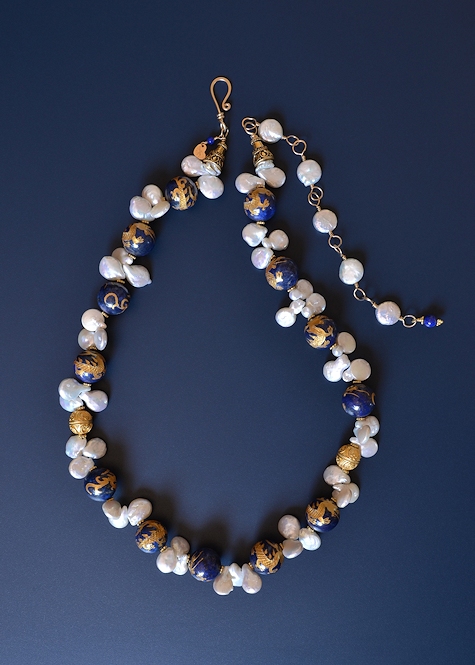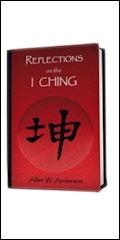These gorgeous big lapis beads were hand-carved with incised dragons then 22kt gold was burnished into the depressions. Burnishing actually causes thin layers of gold to bond to one another. Normally polished agate burnishers rather than steel ones are used to fuse gold and you will find lapidaries make their own burnishers out of fabulous agate instead of depending on commercial waste agate burnishers! We can imagine that whoever made these beads also took the time to make beautiful burnishers in appropriately tiny shapes. White pearls look gorgeous with lapis and represent the pearl (or peach) of wisdom often depicted with flying Chinese dragons.
While the dragon represents positive things in the Chinese tradition including the Son of Heaven (the emperor) and good fortune, it becomes the slimiest, most evil thing imaginable in the West. St. George was a hero for dispatching the dragon as was Gilgamesh before him. We will leave contemplation of this difference to others and focus on the Chinese dragon on these beads which obviously is a noble beast. It is curious that the dragon is the only "mythical" animal mentioned in the I Ching, as far as I'm aware. There are many animals mentioned in the Chinese scripture, e.g., the turtle, horse, mare, deer, tiger, fish, hawk, crane,... doesn't it seem odd to consider the dragon "mythical" when no other animal in the book is? Apparently dinosaur fossils were at one time thought to be from dragons, perhaps that explains it. The Wiki article on the Chinese dragon says that it "evolved" from the stylized depiction of [other] natural creatures. In the references below the children's book Legend of the Chinese Dragon embraces this theory and the role of the dragon as a symbol of hope for an end to war. But we wonder, could these be "convenient explanations" for dragon lore? Do you think that someday we will find dragons really existed... or perhaps still do?! A lot of us hope so!
Liu I Ming (a Taoist/Confucian/Buddhist scholar) mentions in his Taoist I Ching that we are always in the dragon's pool and tiger's lair. Cleary's glossary defines them both as symbols of the world. However, generally speaking, scripture is very spare, very precise. I'm not disputing Cleary's definition, however the dragon's pool and tiger's lair might symbolize different aspects of the world which we must somehow navigate in our lives, otherwise only one of the terms would be necessary. Do you ever feel you are in the tiger's lair or the dragon's pool? Recall that Ramana Maharshi had no fear of tigers. Does that relate to the discussion?
Judy Hall gives lapis lazuli "the power of cosmic correspondence." Cayce mentions that lapis lazuli "acts as it were as a storage of energies of the inner self." We could discuss all the subjects referenced in this necklace at great length. Perhaps besides giving hope for an end to war and good fortune, this necklace would facilitate fascinating discussions. Please order it and enjoy its rich and layered meanings.







